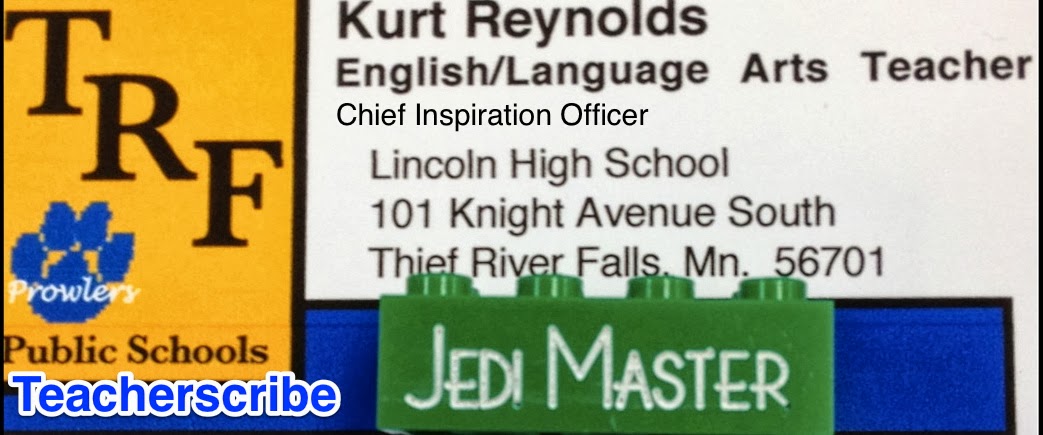Teacherscribe’s Teaching Tip #156
One of the books from my summer reading list a few years ago was Generation iY Tim Elmore.
In his book, Elmore clearly loves acronyms, which might just turn off every single teacher who reads his book, but if you can put up with them, they really are interesting and worth your time.
One of his acronyms that applies to this generation is “EPIC.” Emore states that this is an EPIC generation in several ways.
Here is how that breaks down. I’ll also look at how each term has implications for us as teachers.
C – Connected.
Our students today are connected in ways that we couldn’t imagine when we were their ages.
I grew up in Red Lake Falls, MN. I played summer baseball with Mr. Zutz who came down to stay with his grandparents in the summer.
When summer was over, though, Mr. Zutz went back to Thief River Falls. It’s only 16 miles north of my hometown, but he might as well have been living in Grand Forks or Minneapolis, for I never saw him. We were totally disconnected. Until summer rolled around again.
That’s just not the reality for kids today.
Thanks to social media and their ever-present cell phones, they are always connected.
So, rather than discouraging this, how can we make sue of this in our classes?
Mrs. Stock used to tell me the story of one of her friends who worked at Digi Key. She spent the vast majority of her time training in new workers. The workers went through weeks of practice and training. Yet, when they were turned loose to do their jobs, instead of recalling their training, they opted to converse with their co-workers to problem solve.
This, apparently, frustrated Mrs. Stock’s friend, for it appeared all of her hard work was wasted because they weren’t relying on any of their training.
Sound familiar?
I’m not making an excuse for her workers. I’m just stating a fact: that’s not how the new generation learns best. They don’t learn best in isolation. They grew up being connected and they expect to always stay connected.
And before you – dear teachers – get all high and mighty on us here, how often have you – instead of relying on our yearly Synergy training – rushed to shoot an email to Reid or Natasha instead of relying on your training? How many of you shoot an email to Lynn, Kelly, or Tim when something in Google Drive isn’t working? Why not rely on your training.
Exactly.
If companies and the business world want us to teach students how to learn in isolation, why is it all that we ever hear when it comes to feedback from the business world is that they need workers who can work effectively in teams and problem solve?
It sounds to me that that was just what Connie’s friend’s new employees were doing. They were taught to work in teams and problem solve by connecting with others. It’s not the workers who need to change; it’s the training methods that need to change.
So how can we allow students to do this in our classes? One simple way is to give students new content. Then allow them to get into small groups and answer a well crafted question (not simply yes or no) that allows them to connect with each group member and maybe even others outside of the room to come up with an answer.
Here is one way I try to do it.
When we read Mark Bauerlein’s The Dumbest Generation, which is a research-heavy text. It is daunting to read. So I give it to them in small doses. One of the first chapters attempts to prove that students just aren’t learning as much as previous generations and that what they learn isn’t as complex or sophisticated as pat generations.
I allow the students to self select small groups to answer questions collectively (such as, what evidence does Bauerlein use to support his claims? What personal evidence do you have that either supports or refutes his claims?).
Then I have them work together to connect with others outside of the classroom (the most common approach to this is when students text their parents and get their input on how complex the subject matter is today compared to when their parents grew up – I often here evidence like, “My mom stopped helping me in middle school with my math because it was beyond her” or “Every time the internet goes out, my parents come to me to get it back up again” or “I’d like to see Bauerlein spend an hour playing World of Warcraft or Minecraft when he grew up playing Pong).
Finally, I give them this test for Salina Kansas in the 1800s that supposedly proves that today’s kids don’t know anything compared to someone with an 8th grade education from the 19th century. Then I have them connect with themselves and others to find the holes in this type of thinking and then connect that to what Bauerlein is trying to claim. I love it when students work together to give examples such as, I’d like to see someone from 1835 try to use the internet or a 3-D printer or write a Multi-Genre Essay or make sense of Lost or Dexter. It is even better when students come up with responses such as, “but this type of thinking is fair. You can measure us by a test from 1835, but you can’t take someone from 1835 and have them take my Trigonometry test. It just isn’t fair.”).


No comments:
Post a Comment